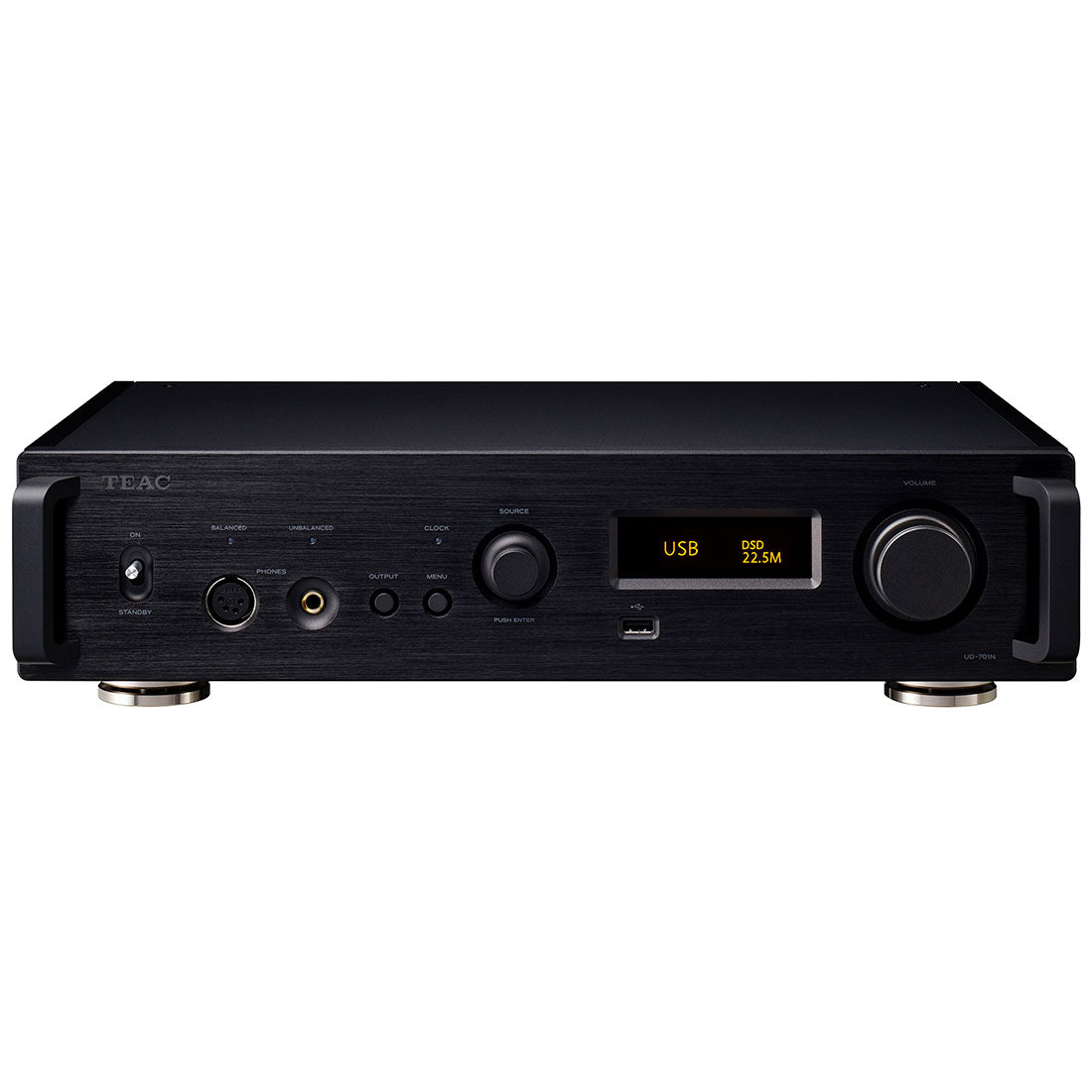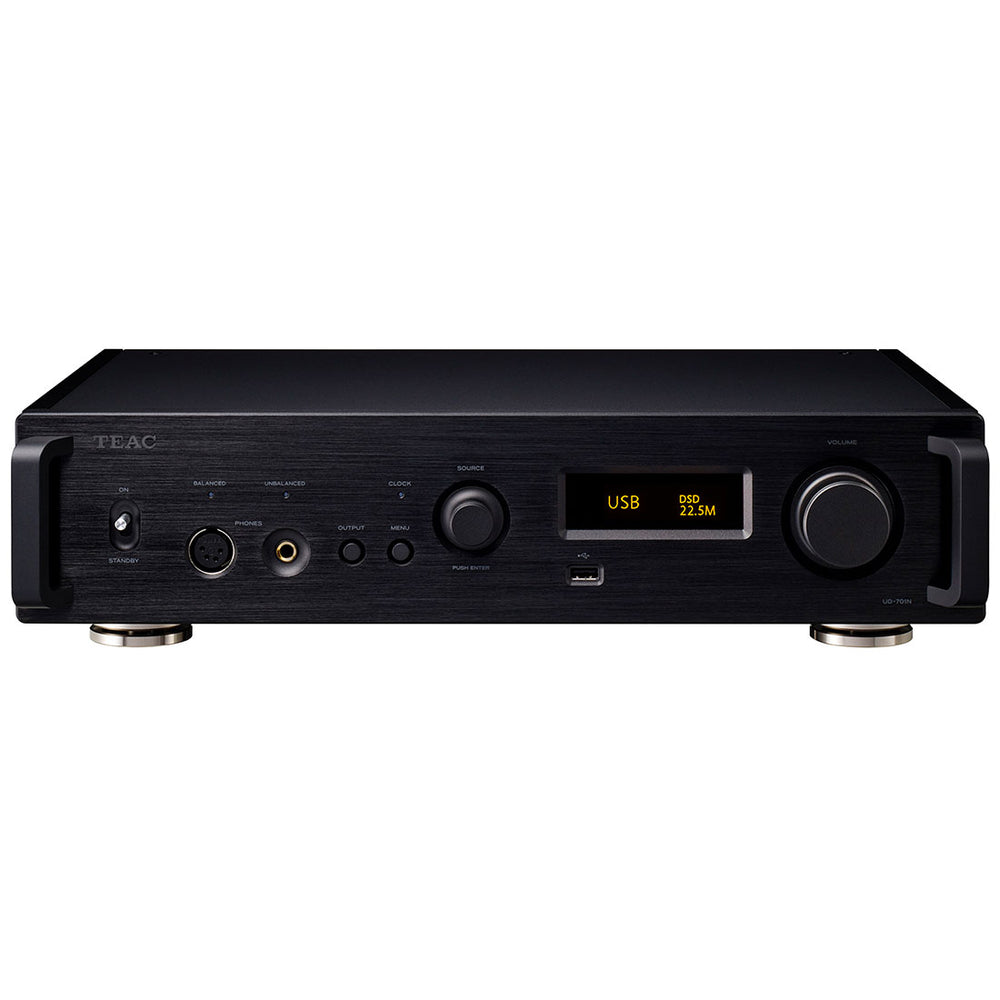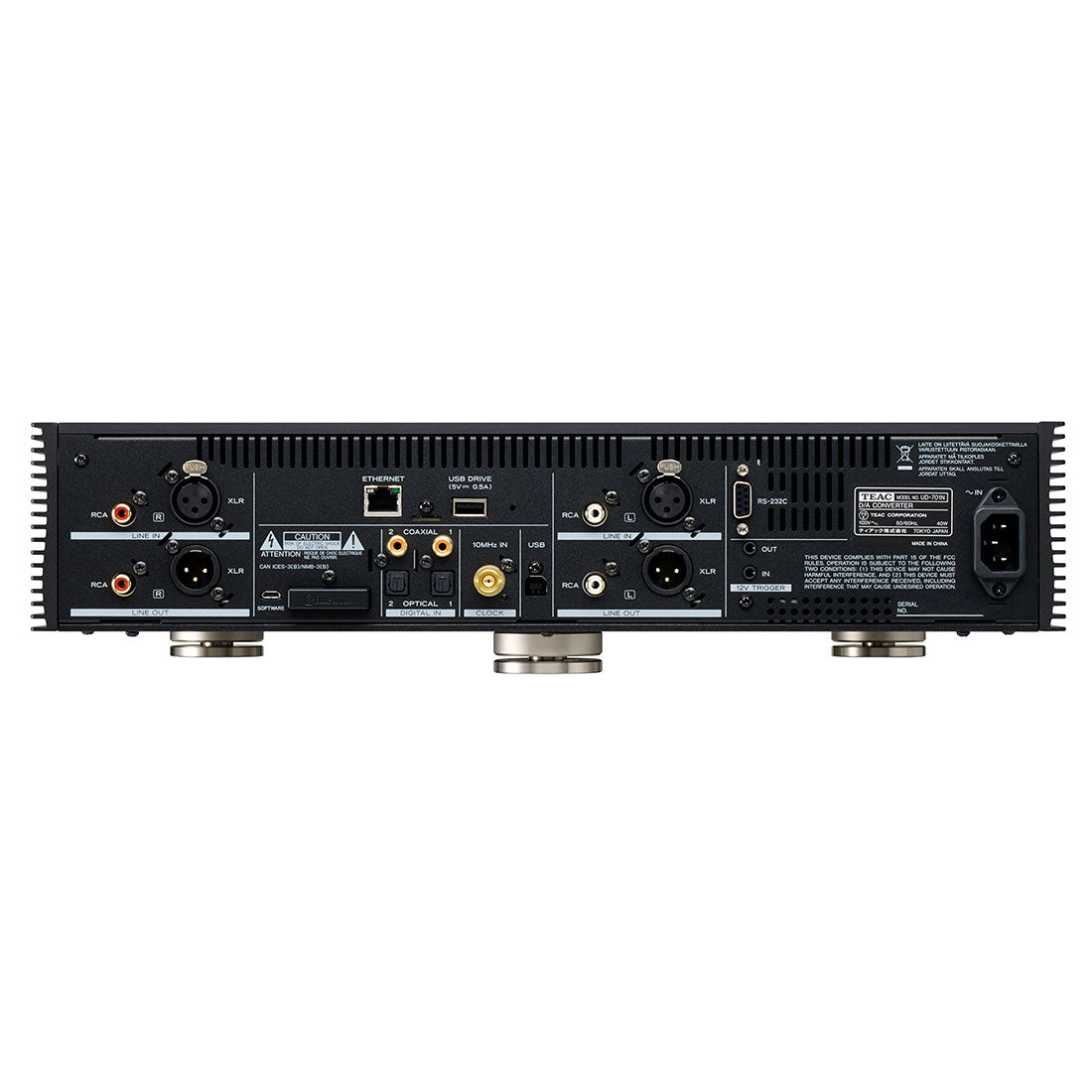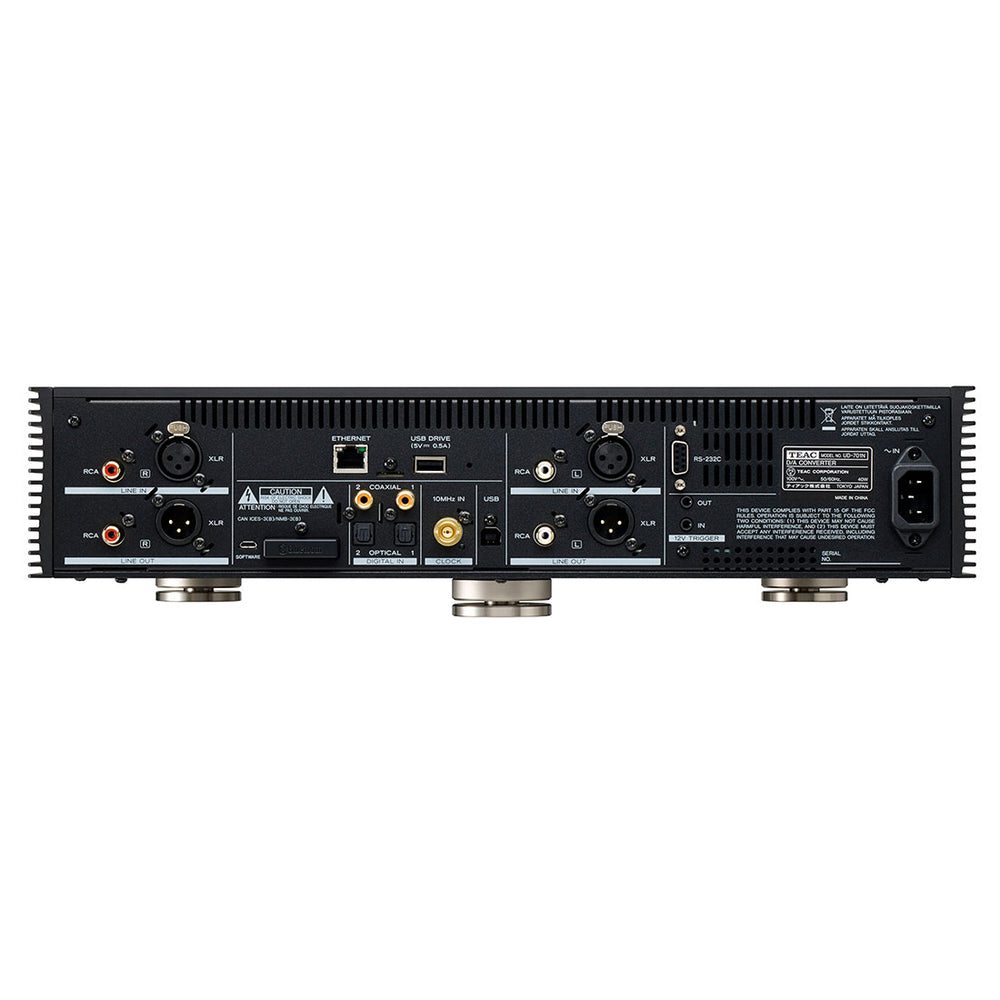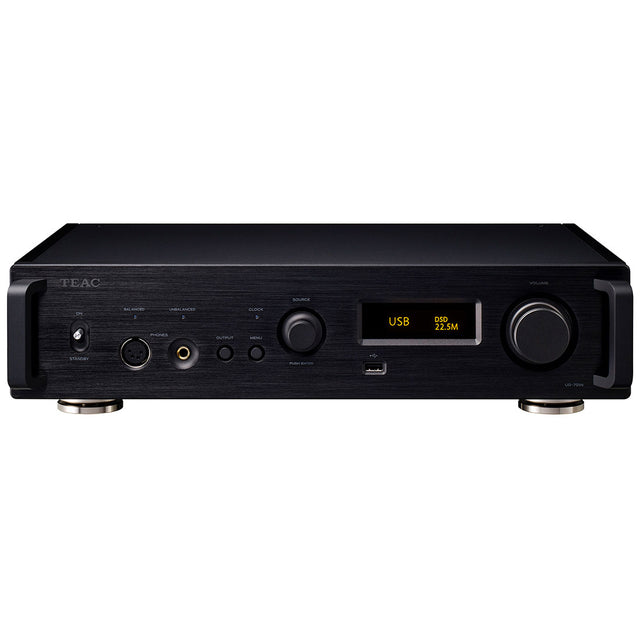
Payment as low as
This monthly payment does not include any applicable tax or interest
Covers shipping up to 7% of product value. If costs exceed this, we'll quote before shipping or cancel and refund.
Free Shipping |
We guarantee the best price in Canada—before or 30 days after purchase.*
Lowest Price Guarantee*
This product is backorderable
Sign up to get notified when it's in stock!
Product Description
Product Description
TEAC UD701NB Reference 700 Series Network Audio Player/USB DAC/Headphone Amp/Preamplifier - Black
Discrete TEAC Delta Sigma Device Recently Designed
For the UD701NB, we implemented a newly created TEAC (Delta Sigma) discrete DAC made of discrete circuitry that uses FPGA and incorporates our unique algorithms rather than using a generic DAC IC. High-quality audio output is produced from analogue signals. While PCM signals are broadcast after going via a modulator and being converted to 1-bit signals, DSD signals are transmitted exactly as they are. We may argue that by realizing this expansive, crystal-clear sound field, made possible solely by the discrete design, TEAC has achieved the highest level of its audio goals. Playback of 22.5MHz DSD and 384kHz/32-bit PCM is available with the TEAC discrete DAC.
Dual-Mono Architecture
From the power circuit with independent left and right toroidal core transformers to the D/A converter section and analogue output stage, we have implemented an elaborate dual mono construction throughout the entire unit. The UD701NB dual model construction prevents interference between the left and right channels by having full mono circuits for each of the two channels. This allows for the production of rich musical expression that replicates the sensation of space and dimension.
Completely Balanced Transmission At All Times
The left and right analogue output signals are totally balanced and are sent from the D/A conversion stage via the final output stage, considerably enhancing the signal-to-noise ratio and expanding the dynamic range. With no loss of the airy quality that high-resolution audio sources have, this transmits signals from the UD701NB in a purer state.
Four Toroidal Core Transformers With Large Capacity
Separate toroidal core transformers are also employed in the network module and digital control sections, in addition to the two toroidal core transformers for the independent left and right analogue signals. In particular, by bolstering the power supply for the network module section with linear power, the network module, which requires advanced processing, is supplied with stable electricity.
Function Of An Analogue Preamplifier With Two RCA/XLR Line Inputs And Four Digital Connections
The UD701NB functions as a high-quality analogue preamplifier in addition to being a USB DAC/Network player with two sets of coaxial and optical digital inputs that let users connect conventional audio sources. Additional analogue audio inputs are provided via RCA and XLR connections. With four independent circuits for left, right, positive, and negative sound (L+, L, R+, and R), our TEAC-QVCS (Quad Volume Control System) is a variable gain amp volume control. The audio signal route makes it as short as possible, which prevents the degradation brought on by drawing audio signals through signal lines. Additionally, because the volume can be changed in incredibly precise 0.5dB increments, you can find the right volume for your headphones or audio system.
TEAC-HCLD2 Enhanced-Current Output Buffer Circuits That Have Been Improved
The enhanced-current output buffer circuits we utilized are called TEAC-HCLD2 circuits, which are upgraded versions of our TEAC-HCLD (TEAC High Current Line Driver) circuits. These increase the current transmitting capacities, which are significant in analogue output circuits. Diamond buffer amplifiers, utilised as line drivers and capable of high current transmission are used in each channel's positive and negative two-circuit architecture. Drive is parallel for unbalanced output and differential for balanced output. Transmission of UD701NB's audio signals with no loss of dynamism is made feasible by increasing the current supply capacity.
4-pin XLR Headphone Amplifier With Active Ground And Balanced Ground Switches
The dedicated UD701NB headphone amplifier uses a total of four diamond buffers to support the usage of balanced drive headphones, one in each of the left, right, positive and negative circuits. Furthermore, they can deliver a stronger drive than standard single-end headphone amplifiers even when used in single-end mode by driving these amps in parallel. This makes it possible to achieve the potential of numerous headphone varieties, including 600 high-impedance headphones. Active ground is a drive technique that approaches 0 V by coupling the COLD connector to the ground and pushing the ground aggressively with an amplifier circuit. It is based on the concepts of a balance connection. When compared to utilising a standard ground, a better ground can be achieved, and the impact of humming noise from the power source can also be reduced. Additionally, we may anticipate that reducing the noise floor will deepen the stillness, enhancing our ability to perceive the artists' breathing and the texture of the sounds on an intimate level.
MQA Complete Decoder With Digital Input Support
A high-quality audio codec called MQA (Master Quality Authenticated) enables playback at the same level of fidelity as studio masters. In order to produce analogue waveforms that are accurate to the original recordings, the UD701NB's MQA decoder controls D/A-converted waveforms with an accuracy as precise as 5 ms. By significantly minimising the "sound blurring" that easily takes place when sounds start abruptly and at other times when sound pressure variations are high, it is possible to generate playback sound that sounds authentic to the human ear.
In addition to file and network playback, MQA data from digital inputs can also be decoded because a complete decoder is incorporated. High-end audio codec MQA (Master Quality Authenticated) permits playback at the same calibre as studio masters. An MQA decoder built into the UD701NB precisely regulates D/A-converted waveforms to provide analogue waveforms that are accurate to the original recordings with an accuracy as little as 5 ms. By significantly minimising "sound blurring," which is a common occurrence when noises begin abruptly and other times when sound pressure variations are high, it is possible to reproduce sound that sounds authentic to the human ear.
The inclusion of a complete decoder allows MQA data from digital sources to be decoded in addition to file and network playback.
Upconversion
RDOT-NEO (Refined Digital Output Technology NEO) is used by the upconversion function to smoothly enhance PCM digital audio streams and upconvert their sample frequencies by 2, 4, or 8 times (384kHz maximum). RDOT is a technology that was created to enable the reproduction and playback of frequencies greater than 20 kHz that are lost by 44.1 kHz/48 kHz digital transmissions. RDOT utilises a comparable interpolation method employing fluency logic. Analogous data is generated between the waveform samples based on the information read, and this also produces data over 20 kHz.
LDAC, AptXTM HD, And Other High-Resolution Transmission Formats Are Supported By Bluetooth® Receivers
It supports the LDACTM and LHDC codecs, which can send audio data with a quality that is regarded as high resolution (96kHz/24-bit), as well as Qualcomm® aptXTM HD, which can transfer audio data at a rate of 48kHz/24-bit. Naturally, the well-liked Qualcomm® aptXTM, AAC, and SBC codecs are also supported, making it simple to take advantage of high-quality wireless playing from smartphones and digital music players. 


